Don’t Waste Your Waste!
The following resources will help you learn how to use your Green Bin.
Kootenay Region
Click Here to See BelowBoundary Region
Click Here to See BelowBe Bear Aware
Click Here to See Below Backyard Composting
Click Here to See Below Prevent Food Waste
Click Here to See Below
Kootenay Curbside Collection: Green Bin
How does the curbside collection program work?
Starting October 2023 homes in Rossland, Warfield, Trail, Montrose, Fruitvale, and Areas A & B will receive weekly curbside collection of organic kitchen scraps.
Fill the kitchen bucket with the proper materials and dump it into your green bin when full. Each week, the green bin will be collected.
Download the Kootenay Region Green Bin User Guide for a printable version of the information below, with tips on what can and can't go in your green bin, how to reduce the "yuck" factor, and much more!
Fill the kitchen tote with the proper materials and dump it into your green bin when full. Each week, the green bin will be collected.
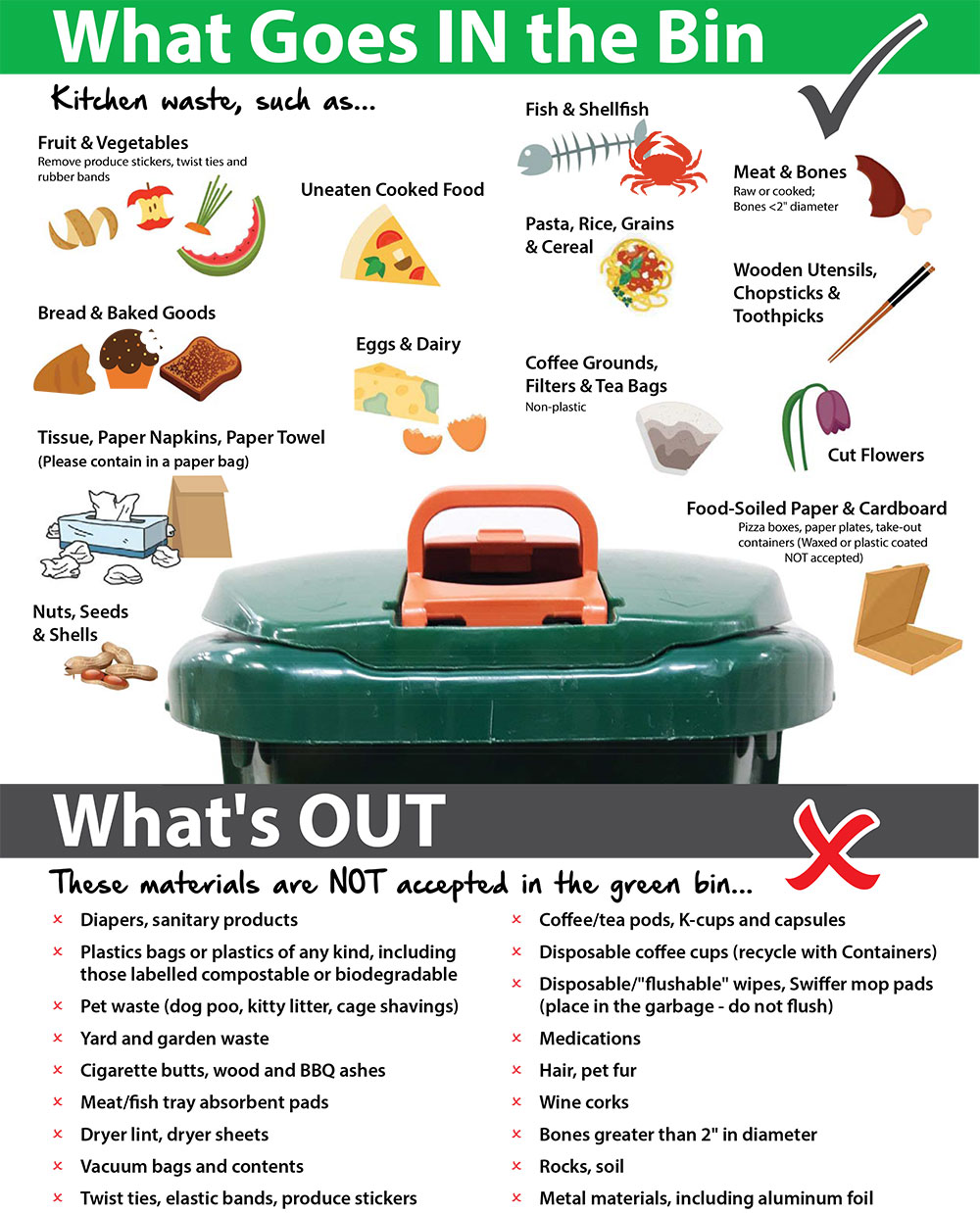
The standard 80 litre green bin distributed to residents free of charge by the RDKB are critter-resistant (to racoons, rodents, etc.) but not bear-resistant. With this is mind, it’s important that you store and manage your bin properly to not attract bears.
Interagency Grizzly Bear Committee ‘certified bear-resistant’ green bins are available for purchase through our bear bin trade-in program, for RDKB residents who live in bear-frequented areas and are unable to keep their bins secured:
- Step 1 – Fill out the Bear Bin Trade-In form here or call us and we will fill it out for you!
- Step 2 – You will be contacted by RDKB staff to confirm bin availability and arrange for payment and a pickup time at the McKelvey Creek Landfill.
- Step 3 – Bring your CLEAN 80 litre standard critter-resistant bin to the McKelvey Creek Landfill for trade-in at the pre-arranged date and time.
- Step 4 – Pay and pick up your new bin. Trade-in cost is $200 including GST.
Note: Once you purchase a Bear Bin, you keep it! If you move to another residence, let the RDKB know, and take your bin with you.
Bear resistant bins are not available for Boundary residents at this time.
Contact us at
knowwaste@rdkb.com
Tel. 250.368.9148 (Toll-Free: 1.800.355.7352)
There are several reasons why your green bin may get left behind. The following items are not permitted in your green bin:
- Plastic bags, including those labeled compostable or biodegradable – use cellulose-lined paper bags or line your bins with newspaper, cardboard or boxboard
- Yard and garden waste. Check your municipality’s website for scheduled yard and garden collection days or take yard and garden waste directly to McKelvey Creek Landfill. Tipping fees apply.
- Loose tissue/paper towel/powdery materials such as flour, sawdust or contents of vacuum canisters – contain in a heavy paper bag
- Diapers – please place in the garbage
- Pet waste (dog poo, cat litter, cage shavings) – place in the garbage
- Plastics and metal – please recycle
- Coffee/tea pods – empty, rinse and recycle with Containers
- Disposable coffee cups – please recycle with Containers
- Produce stickers/labels/tape
Your bin may also not get picked up if it’s too dirty – be sure to clean in regularly!
Check out our Kootenay Region Green Bin User Guide for a printable version of accepted items!
Kootenay residents (Rossland, Warfield, Trail, Montrose, Fruitvale, and Areas A & B): If your garbage, green bin or recycling was not picked up and you did not receive an ‘Oops!’ sticker, call GFL Environmental 250-367-0099.
- Many “yuck” problems are caused by moisture content in food. Drain your food scraps before placing in the bin.
- Keep the bottom of your bins dry by lining them with crumpled newspaper, boxboard, cardboard or fibre egg cartons.
- Use a cellulose-lined paper bin liner such as the Bag to Earth brand bag or a paper yard waste bag. DO NOT use plastic bags to line your bins, even if labeled compostable or biodegradable.
- Wrap food waste in newspaper, old flyers or boxboard before placing in your bins.
- Freeze smelly food scraps such as meat, fish and bones in newspaper or paper bags and place in your curbside bin on collection day.
- Alternate layers of kitchen scraps with layers of soiled paper products.
- Keep the lid tightly closed to keep out flies.
- Use vinegar, salt, garden lime or diatomaceous earth to kill maggots.
- In the summer, keep your bin in a cool, shaded spot so that it doesn’t get too hot and smelly.
- Put your green bin out for pick-up on your scheduled collection day, even if it isn’t full.
- Clean your bins regularly with mild soap and water.
- Spray vinegar or sprinkle baking soda in the bin to reduce odours.
Many of the same tips mentioned above will also help if you are having trouble with food scraps freezing to your green bin:
- Use a Bag to Earth liner or line your bin with crumpled newspaper, cardboard, boxboard or fibre egg cartons.
- Wrap food scraps in newspaper before placing into your bin.
- Drain liquids before placing food scraps in the bin.
Store your bin in a garage or other warm space.
Contact your municipal office to inquire about your specific yard and garden waste collection program for your area.
- Garden Waste IS accepted in the Green Bin: Fruits, veggies, plants, stems, stalks, garden ‘leaves’, flowers, yard weeds (not noxious weeds please), indoor flowers/plants… and the list goes on. Make sure items are less that 12” in length and less than 2” in diameter.
- Not accepted in the Green Bin: No grass clippings, no raked leaves, no branches, no wood chips, no rocks or soil.
Yard and garden waste may be taken to McKelvey Creek Landfill. Tipping fees apply.
Kootenay area businesses and service providers are encouraged to participate in the RDKB organic waste diversion program. Tipping fees for organic waste are significantly lower than for mixed garbage, providing a strong financial incentive for large producers of organic waste to join the program.
Boundary/West Boundary Curbside Collection: Green Bin
The Boundary region was the first rural area in the B.C. Interior to provide residents with a waste diversion program targeting food scraps and kitchen scraps.
Fill the kitchen tote with the proper materials and dump it into your green bin when full. Each week, the green bin will be collected.

There are several reasons why your green bin may get left behind. The following items are not permitted in your green bin:
- Plastic bags, including those labeled compostable or biodegradable – use cellulose-lined paper bags or line your bins with newspaper, cardboard or boxboard
- Yard and garden waste. Check your municipality’s website for scheduled yard and garden collection days or take yard and garden waste directly to McKelvey Creek Landfill. Tipping fees apply.
- Loose tissue/paper towel/powdery materials such as flour, sawdust or contents of vacuum canisters – contain in a heavy paper bag
- Diapers – please place in the garbage
- Pet waste (dog poo, cat litter, cage shavings) – place in the garbage
- Plastics and metal – please recycle
- Coffee/tea pods – empty, rinse and recycle with Containers
- Disposable coffee cups – please recycle with Containers
- Produce stickers/labels/tape
Your bin may also not get picked up if it’s too dirty – be sure to clean in regularly!
Check out our Boundary Region Green Bin User Guide for a printable version of accepted items!
Boundary residents (Christina Lake, Grand Forks, Greenwood, Midway and Areas C, D and E – excluding Big White): If your garbage, green bin or recycling was not picked up and you did not receive an ‘Oops!’ sticker, call GFL Environmental at 250-442-1538.
Boundary region residents: If you are new to the Boundary area and need a green bin or if your bin has been damaged by the collection truck, please fill out and submit this form, call the RDKB office at 250-368-0231, or email us.
- Many “yuck” problems are caused by moisture content in food. Drain your food scraps before placing in the bin.
- Keep the bottom of your bins dry by lining them with crumpled newspaper, boxboard, cardboard or fibre egg cartons.
- Use a cellulose-lined paper bin liner such as the Bag to Earth brand bag or a paper yard waste bag. DO NOT use plastic bags to line your bins, even if labeled compostable or biodegradable.
- Wrap food waste in newspaper, old flyers or boxboard before placing in your bins.
- Freeze smelly food scraps such as meat, fish and bones in newspaper or paper bags and place in your curbside bin on collection day.
- Alternate layers of kitchen scraps with layers of soiled paper products.
- Keep the lid tightly closed to keep out flies.
- Use vinegar, salt, garden lime or diatomaceous earth to kill maggots.
- In the summer, keep your bin in a cool, shaded spot so that it doesn’t get too hot and smelly.
- Put your green bin out for pick-up on your scheduled collection day, even if it isn’t full.
- Clean your bins regularly with mild soap and water.
- Spray vinegar or sprinkle baking soda in the bin to reduce odours.
Many of the same tips mentioned above will also help if you are having trouble with food scraps freezing to your green bin:
- Use a Bag to Earth liner or line your bin with crumpled newspaper, cardboard, boxboard or fibre egg cartons.
- Wrap food scraps in newspaper before placing into your bin.
- Drain liquids before placing food scraps in the bin.
Store your bin in a garage or other warm space.
Boundary/West Boundary Region (excluding City of Grand Forks)
There is no curbside collection of yard and garden waste for Boundary/West Boundary residents (excluding the City of Grand Forks). Yard and garden waste may be taken to the Grand Forks or West Boundary (Greenwood) landfill or any staffed transfer station.Tipping fees apply.
- Garden Waste IS accepted in the Green Bin: Fruits, veggies, plants, stems, stalks, garden ‘leaves’, flowers, yard weeds (not noxious weeds please), indoor flowers/plants… and the list goes on. Make sure items are less that 12” in length and less than 2” in diameter.
- Not accepted in the Green Bin: No grass clippings, no raked leaves, no branches, no wood chips, no rocks or soil.
City of Grand Forks Yard and Garden Waste Collection
Yard and garden waste collection is provided to City of Grand Forks residents once a month from March to November. This service is provided by the RDKB and City of Grand Forks to look after materials originating on City right-of-way. To ensure that your materials are picked up, please adhere to the following guidelines. Check your collection schedule for dates.
Yard and garden waste must be sorted into two different piles for collection: leaves and grass, and sticks and branches. You are permitted a maximum of 3 bags/bundles per month.
Leaves and grass:
- Container must weigh less than 23kg/50lbs
- No rocks or garbage
- Plastic bags are not allowed. Please use cardboard boxes, paper bags or reusable containers such as a bin/can.
Sticks and branches:
- Sticks must be bundled with biodegradable twine
- Bundles must weigh less than 23kg/50lbs
Bundle length must be less than 1 metre/3.3 feet
Please place your materials at the curb by 8:00 a.m. on the morning of pick-up – not the night before.
The RDKB and the City of Grand Forks encourage residents to use alternatives to the curbside collection service. Options to consider:
- Leave grass clippings to decompose on your lawn after mowing
- Mulching your leaves returns nutrients and helps in developing a healthy soil structure, which aids in retaining moisture
- Build a backyard compost bin or place leaves and grass on your garden or hedge as mulch
Help eliminate illegal dumping of yard and garden waste in back alleys and green spaces. Please take leadership in your community and demonstrate full responsibility for all the organic materials you generate on your property.
Boundary and West Boundary area businesses and service providers are encouraged to participate in the RDKB organic waste diversion program. Tipping fees for organic waste are significantly lower than for mixed garbage, providing a strong financial incentive for large producers of organic waste to join the program.
In the Boundary region, all food scraps and yard and garden waste end up at the Grand Forks Regional Landfill where it is turned into compost.
Green bin waste is mixed in proper proportion with yard and garden waste and wood waste, and is piled into large mounds on a lined concrete pad. The pad has a system of built-in aeration tubes that allows air to be blown into and circulated throughout the mounds. Each mound is covered with a breathable GORE® fabric tarp that allows for the management of temperature, moisture level and odour. Liquid that drains from the mounds is collected and added back to the piles to adjust moisture content.
When the air is pumped in, the GORE® cover expands like a balloon, creating the perfect snug environment for the organic waste to break down. Temperatures in the mounds reach levels that kill pathogens and weed seeds. The first stage of the process takes about 8 weeks, after which the composted material is left to cure. It’s then screened to remove large, uncomposted materials. The result is a nutrient-rich compost that is a valuable resource for improving soil.
BE BEAR AWARE
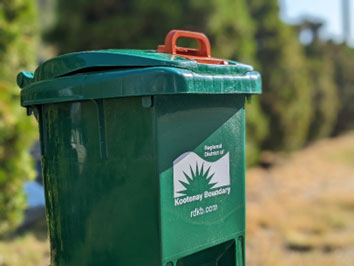 We live in bear country and that comes with the responsibility of taking action to prevent human-bear conflict. The single best way to help keep the public and bears safe is by ensuring that attractants, such as garbage, pet food and birdseed, are securely stored.
We live in bear country and that comes with the responsibility of taking action to prevent human-bear conflict. The single best way to help keep the public and bears safe is by ensuring that attractants, such as garbage, pet food and birdseed, are securely stored.
The standard 80 litre green bins distributed to residents free of charge by the RDKB are critter-resistant (to raccoons, rodents, etc.) but not bear-resistant. With this in mind, it's important that you store and manage your green bin properly. Following are some tips on how to bear-safe your green bin, garbage and property...
How to Secure Your Green Bin from Bears
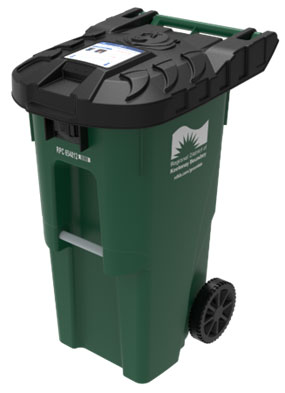
- Store your garbage, recycling and green bins in a secure building when not out for collection, e.g. in a closed, locked garage or shed, even if empty – bins will hold a residual smell.
- If a bin is stored outside, anchor it to a post using a cable so that it can’t be dragged away.
- Place bins at the roadside only on the morning they are collected – never the night before.
- Take it out to the curb every week, even if you only have a small amount of organics in the bin.
- Minimize odours by freezing meat, fish and other smelly food scraps, and don’t put them in the green bin until collection day.
- Keep bins clean... see ‘Tips to Reduce the “Yuck” Factor’.
- Set out your bins by 7:30 a.m. on your collection day and bring them in after collection as soon as possible. DO NOT put them out the night before.
Certified bear-resistant green bins are available for purchase, through our bear bin trade-in program, for RDKB residents who live in bear-frequented areas and are unable to keep their bins secured. If you are interested in purchasing a bear-resistant green bin, please fill out the Bear Bin form, contact us at knowwaste@rdkb.com or call 250.368.9148 (Toll-Free: 1.800.355.7352).
Set out your bins by 7:30 a.m. on your collection day and bring them in after collection as soon as possible. DO NOT put them out the night before.
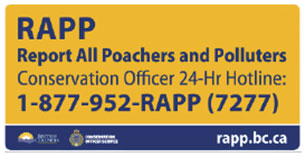
To report human-wildlife interactions where public safety may be at risk, call the Conservation Officer
Under the BC Wildlife Act (Section 33.1), the public is legally responsible to secure waste and other attractants away from dangerous wildlife.
Backyard Composting
Backyard composting is a great way to create compost at home with your own kitchen scraps, leaves, grass clippings and other yard and garden waste. The following information provides a brief overview to help you get started.
There are many great online resources with instructions on how to build your own backyard compost bin, including YouTube, Pinterest and how-to websites. An online search for “free compost bin plans” will turn up lots of great resources, such as these from WoodworkersWorkshop.com.
- Start by adding a little soil and then dropping in your food and yard waste
- Keep it moist and covered
- Chop up large, tough materials
- Stir it up regularly to ensure air flow
- Throw in some worms to speed up the process
- Alternate by layers of the key ingredients (see chart to right)
My compost pile has a bad odour.
Your pile is either too wet or isn’t getting enough air. Turn it and try to add coarse, dry material like straw or corn stalks.
My compost pile is dry throughout.
You’ve either added too much woody material or not enough water. Turn it, moisten, add fresh waste and cover.
My compost pile is damp and warm in the middle but nowhere else.
Your pile is likely too small. Collect more material and mix the old ingredients into the new pile.
My compost pile is damp and sweet-smelling but still won’t heat up.
Your pile is lacking nitrogen. Use the composting chart above to add more nitrogen-rich waste like fresh manure, grass clippings or ammonium sulphate.
My compost pile is being infested by pests.
You may have added meat, fat, bones or other animal waste that is attracting rats, dogs and other animals. Use the composting chart to make sure you’re adding the right items and make sure your pile is properly covered. Place any fruit or vegetable waste in the centre of the pile and cover with soil.
You can compost year round. Materials that you add to your bin during the winter will decompose more slowly as the temperature drops and the pile may freeze solid, but as soon as the weather turns warmer, the process will become active again.
Cold temperatures are actually beneficial, as the freezing action breaks down the fibres in organic material which aids in decomposition once it thaws out.
Be sure there is plenty of room in your compost bin in the fall so you can keep adding materials throughout the winter. To avoid filling your bin with leaves in fall, you can compost some in a separate bin or pile, save some to add gradually to your bin throughout the winter, use some as a mulch or dig some directly into the garden.You should also harvest finished compost in the fall to make room for fresh materials over the winter.
An alternative to backyard composting in the winter is composting indoors with worms. Because worms cannot survive cold temperatures, worm composting has traditionally been done indoors year round, or outdoors in the warm months and indoors in the winter.
Every year, dozens of bears are destroyed in the RDKB. Living harmoniously with bears may require a complete change in attitude. The key to composting in bear country is understanding that bears find food with their noses. If your compost pile does not smell, it will probably not attract bears.
Tips for keeping your compost bear-proof:
- Don’t add cooked or leftover food scraps to your pile
- Maintain at least a 3:1 carbon (leaves, for example) to nitrogen (vegetable scraps) ratio
- Keep your bin aerated by turning it regularly
- Mix in a handful of leaves or sawdust when adding kitchen waste
- Place your bin in an area that is more difficult for bears to find and keep it away from ‘known bear pathways’
- Try ‘trenching’ smelly foods deep in your garden
- Consider a worm bin
Worm composting is simply composting with worms! It’s ideal for apartment dwellers or those with limited mobility, and for year-round and indoor composting. The type of worm used is the “Red wiggler,” whose natural environment consists of slightly moist decomposing materials. This environment can be simulated by a properly built and maintained worm bin.
PREVENT FOOD WASTE
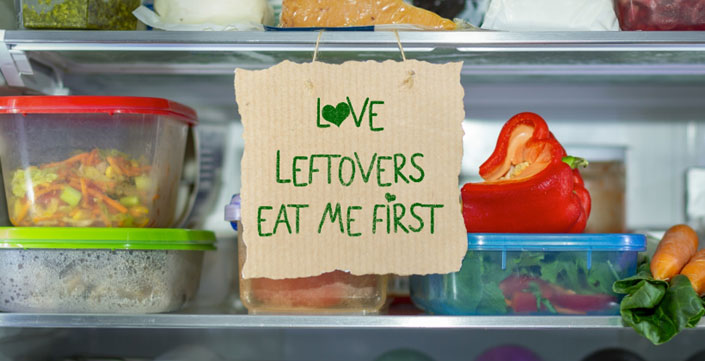
In 2022 the National Zero Waste Council conducted research on household food waste in Canada and found that 63% of the food Canadians throw away could have been eaten. For the average Canadian household that amounts to 140 kilograms of wasted food per year – at a cost of more than $1,300 per year!
The best way to prevent food waste is to purchase less food, store food properly, better utilize leftover food for meals, and freeze food.
Tips to Help Prevent Edible Food Loss
Plan it Out
- Plan your meals in advance (preferably a week at a time).
- Make a shopping list and check your cupboards to see what you have on hand.
- Don’t make too much food. Only make what you know you will eat.
Keep it Fresh
- Keep foods fresh - organize your fridge properly.
- Know the shelf life of the products you purchase. Learn about the different types of date labelling and what they actually mean.
- Learn which foods should be refrigerated and which should not.
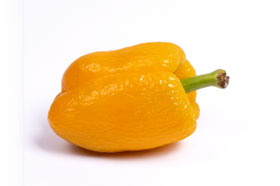 Use it Up
Use it Up
- Cook perishable foods first.
- Pack leftovers for lunch and take them to work or school the next day.
- Split and share large bundles of fresh herbs with friends or neighbours.
Preserve It
- Use your freezer - it’s the easiest way to preserve food.
- Learn to make lacto-fermented foods such as sauerkraut or kimchi. It’s easy to make, delicious and nutritious!
- Dehydrate or can your excess fruits and vegetables.
Visit LoveFoodHateWaste.ca for more tips on preventing food waste, including recipes and food storage guides.